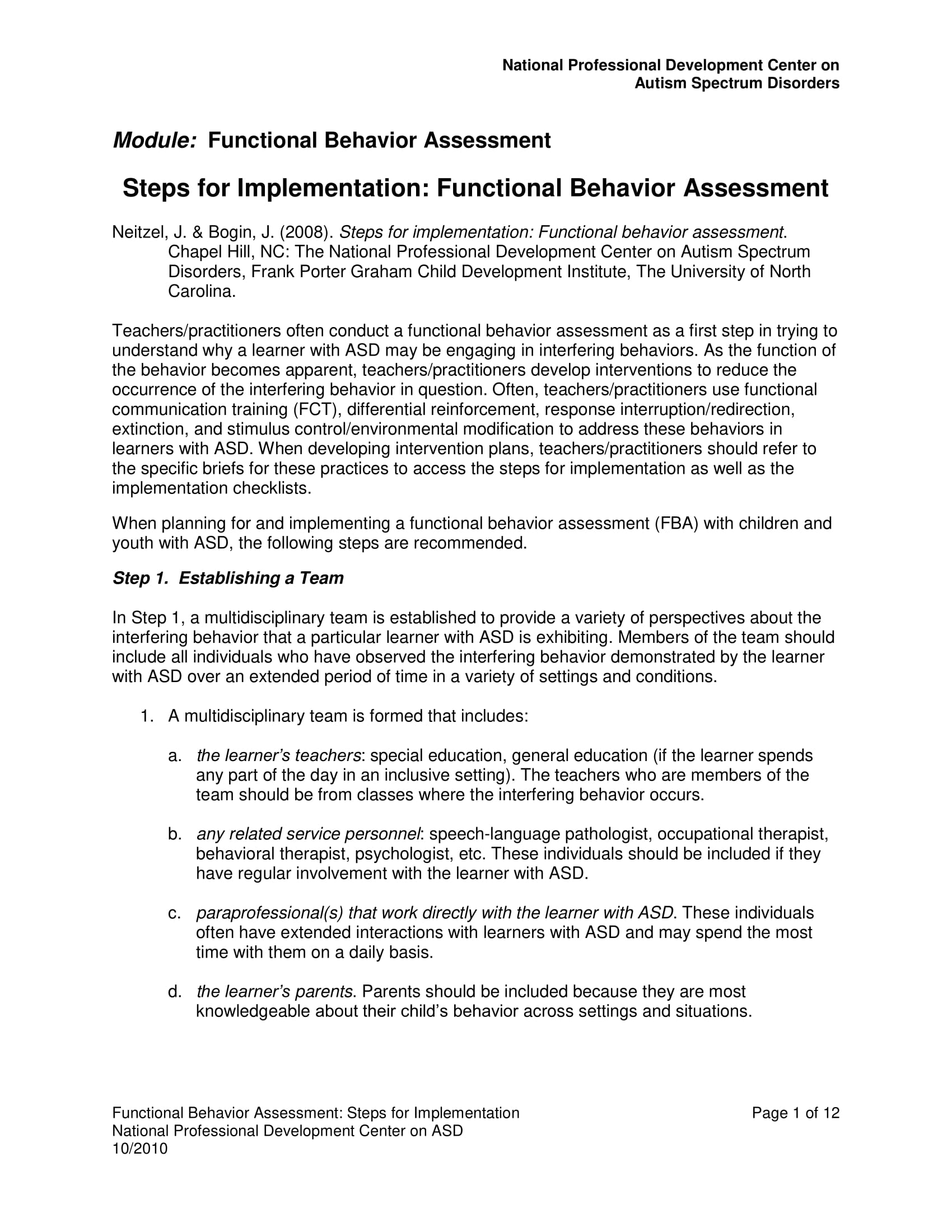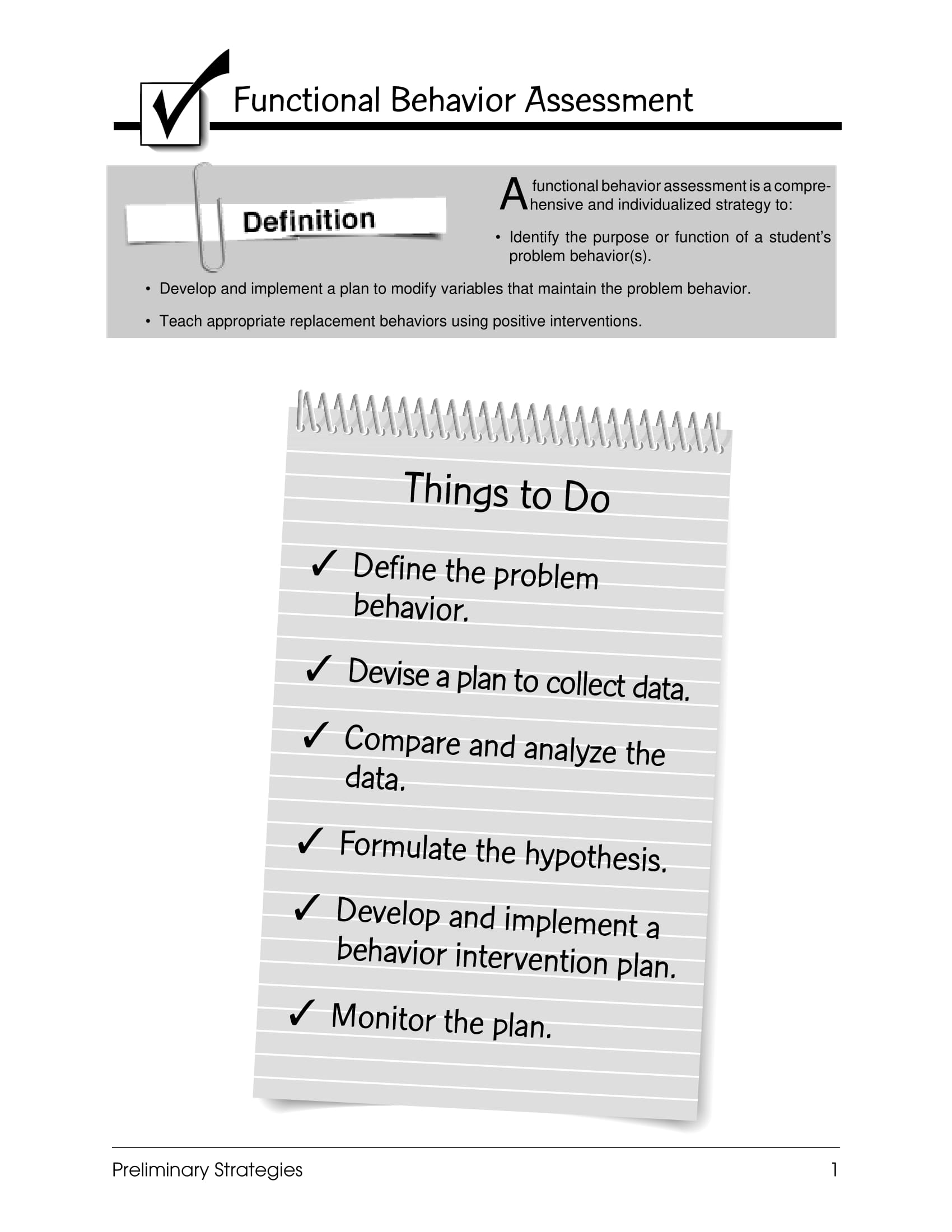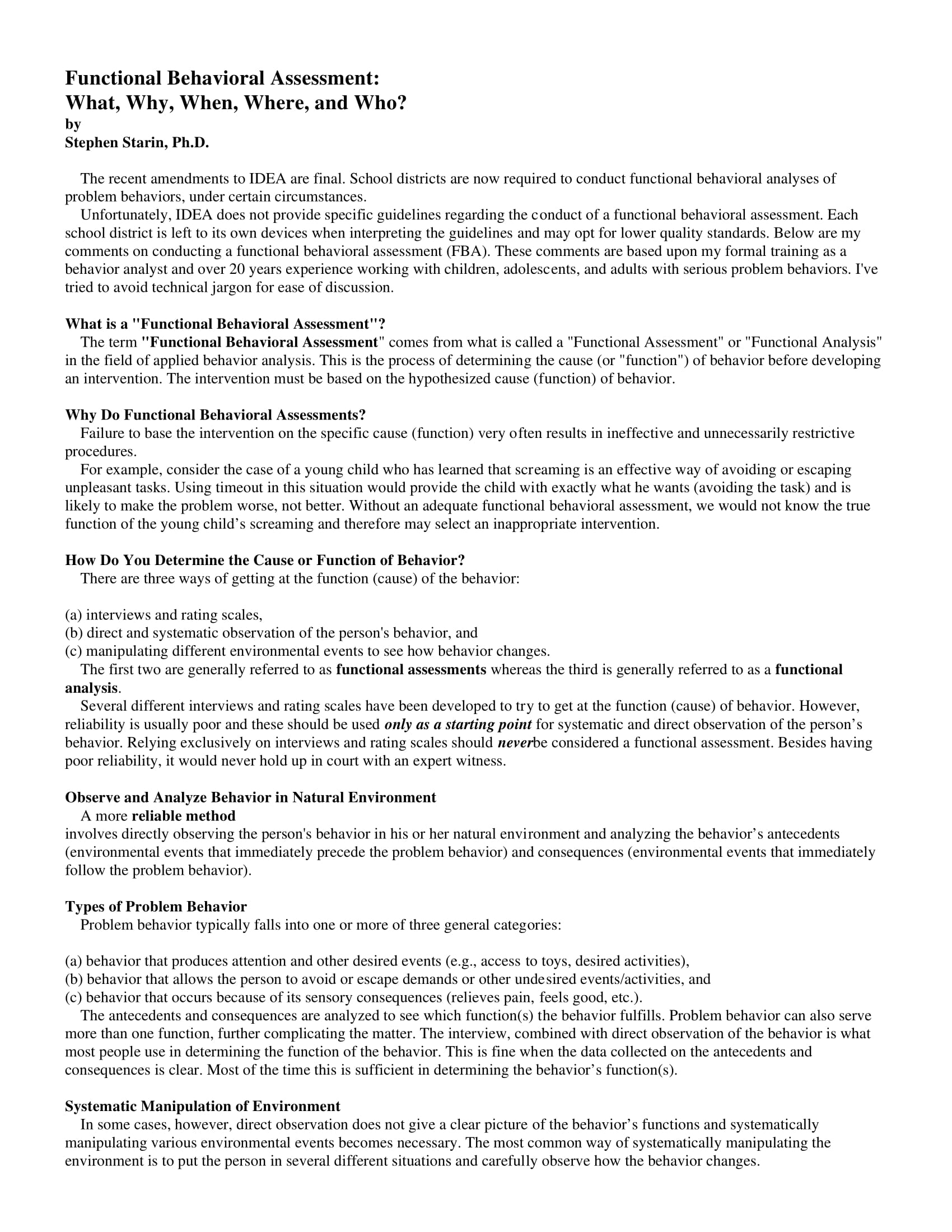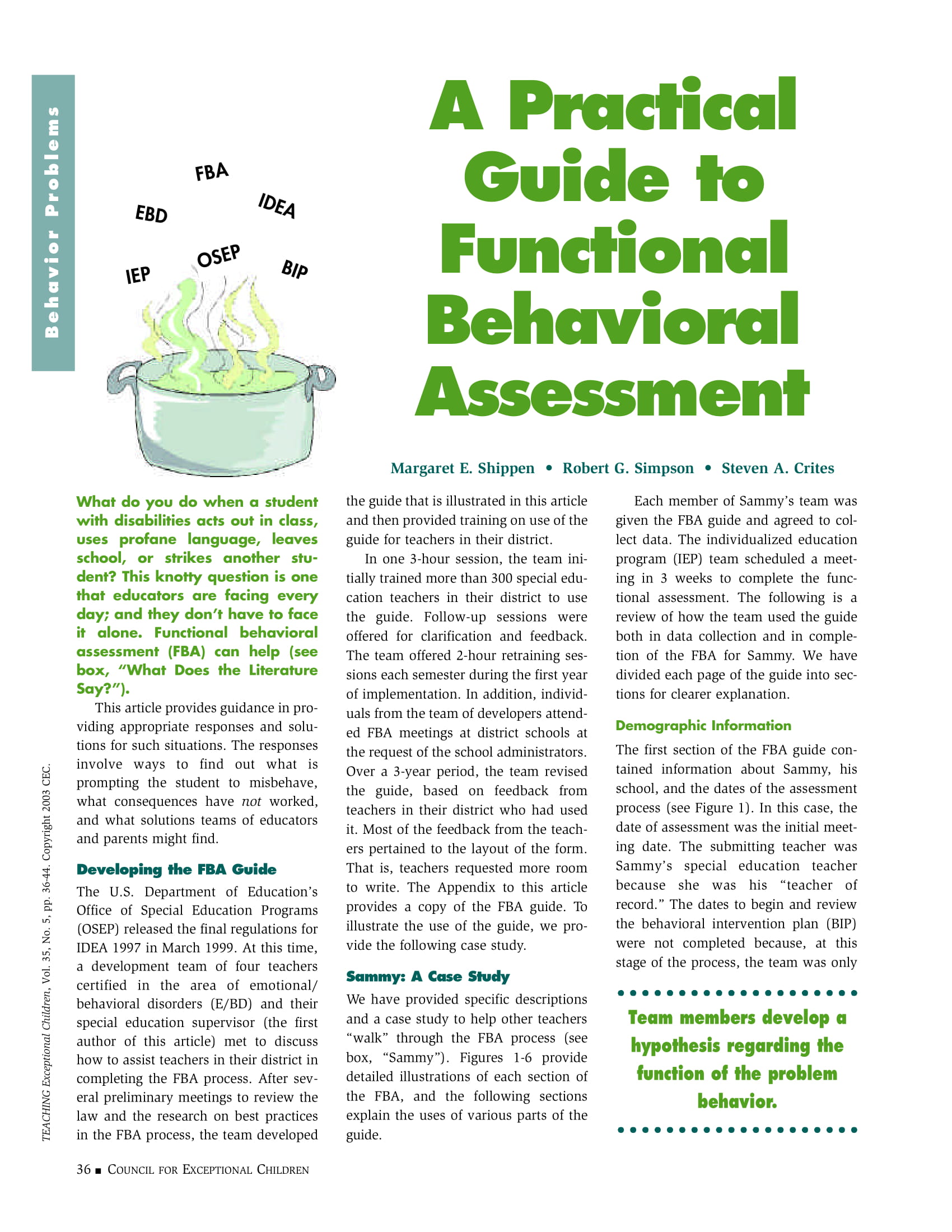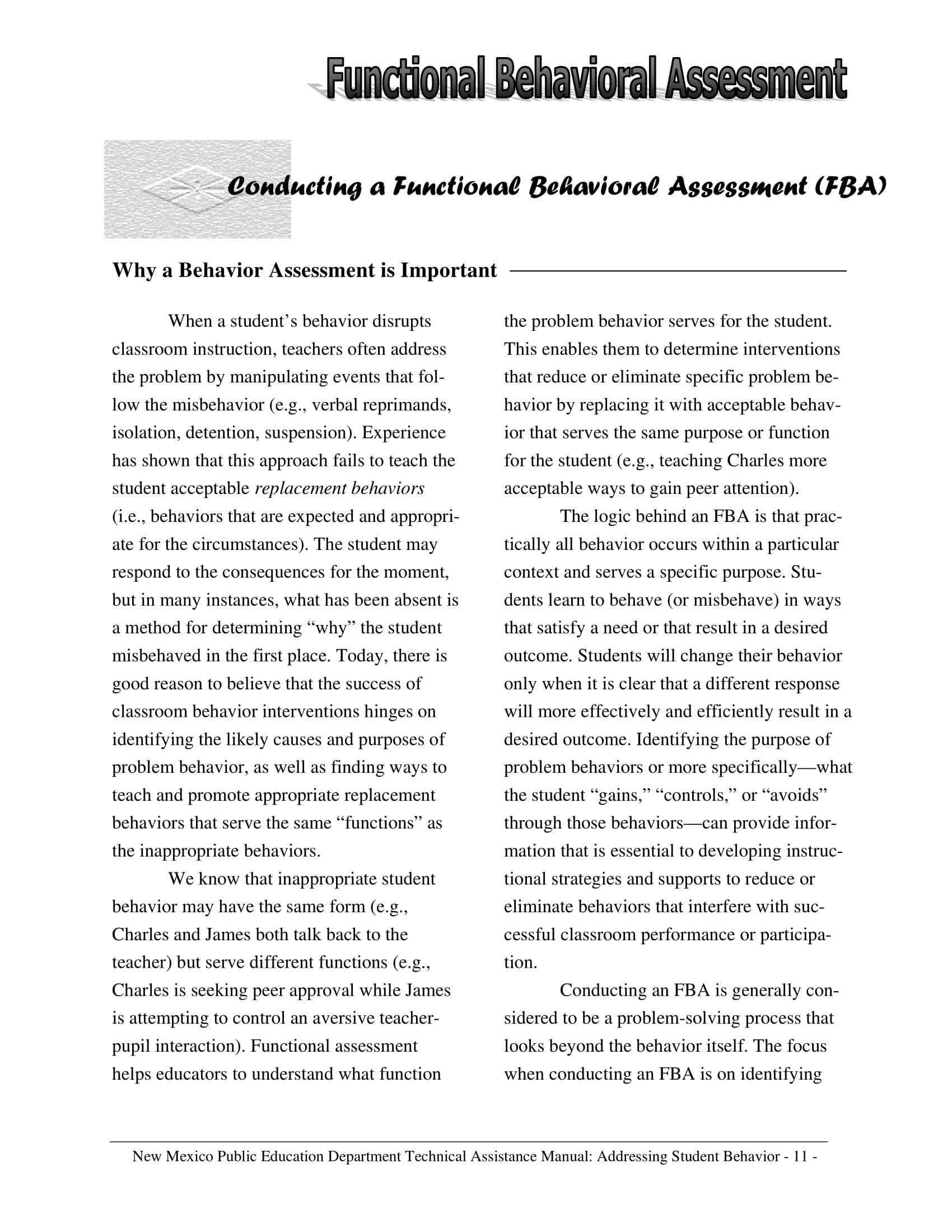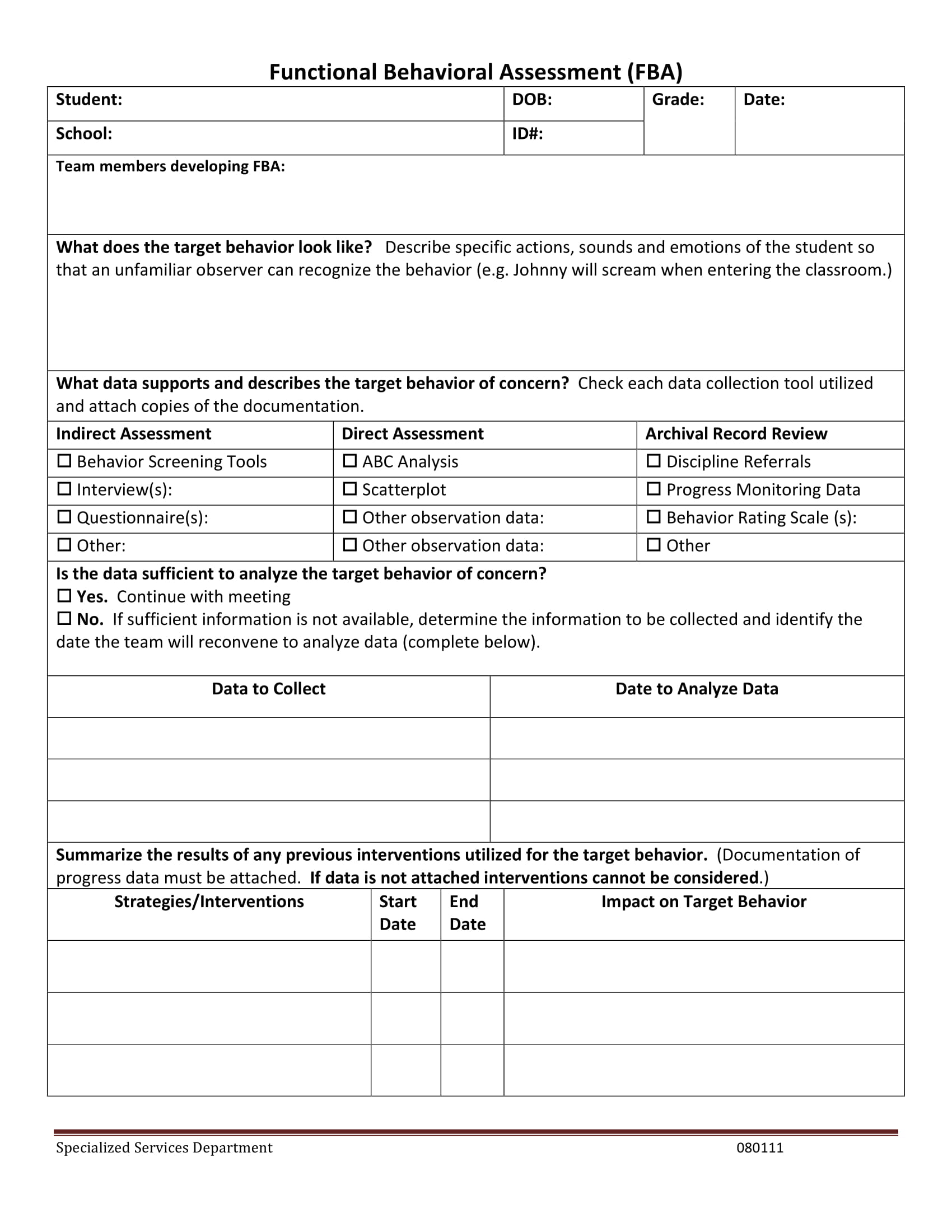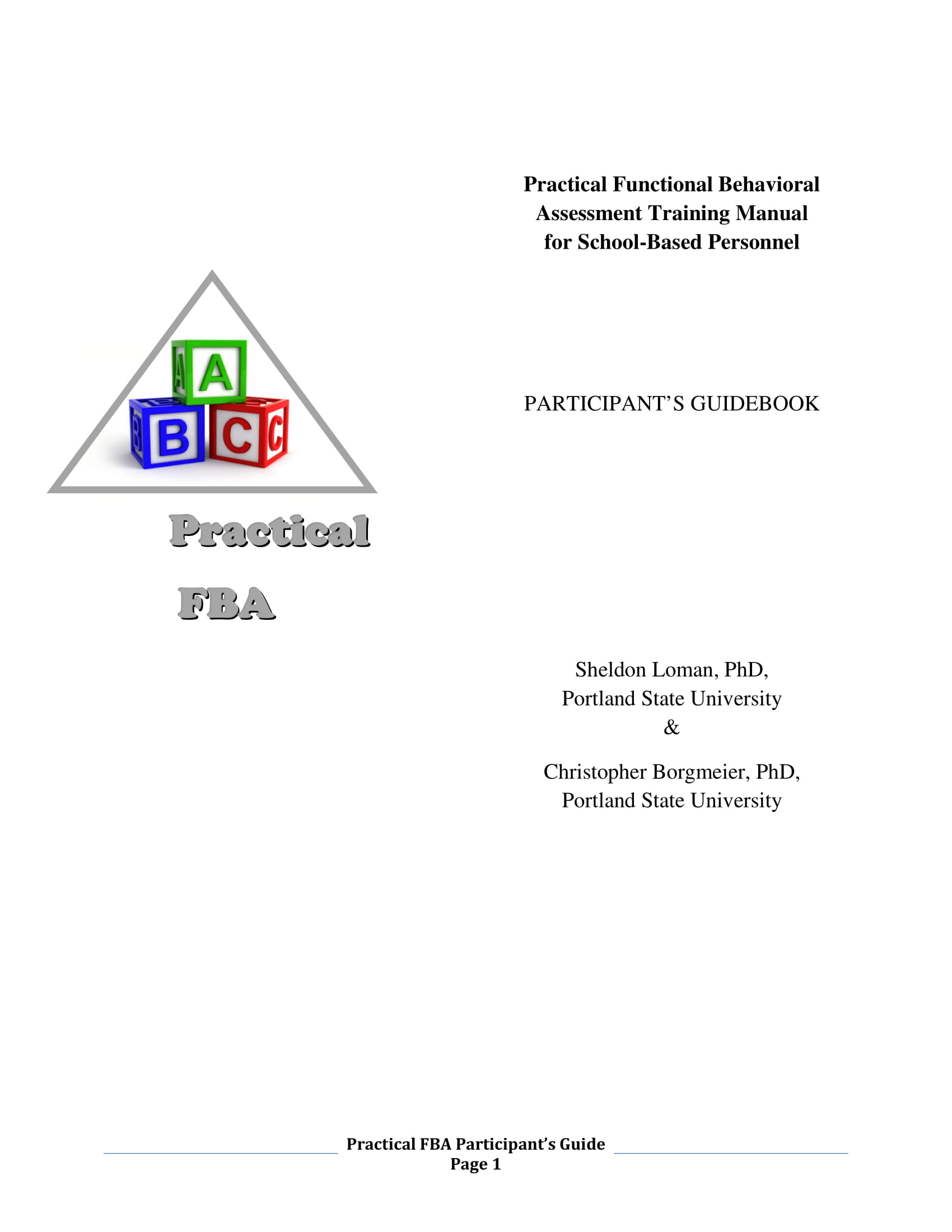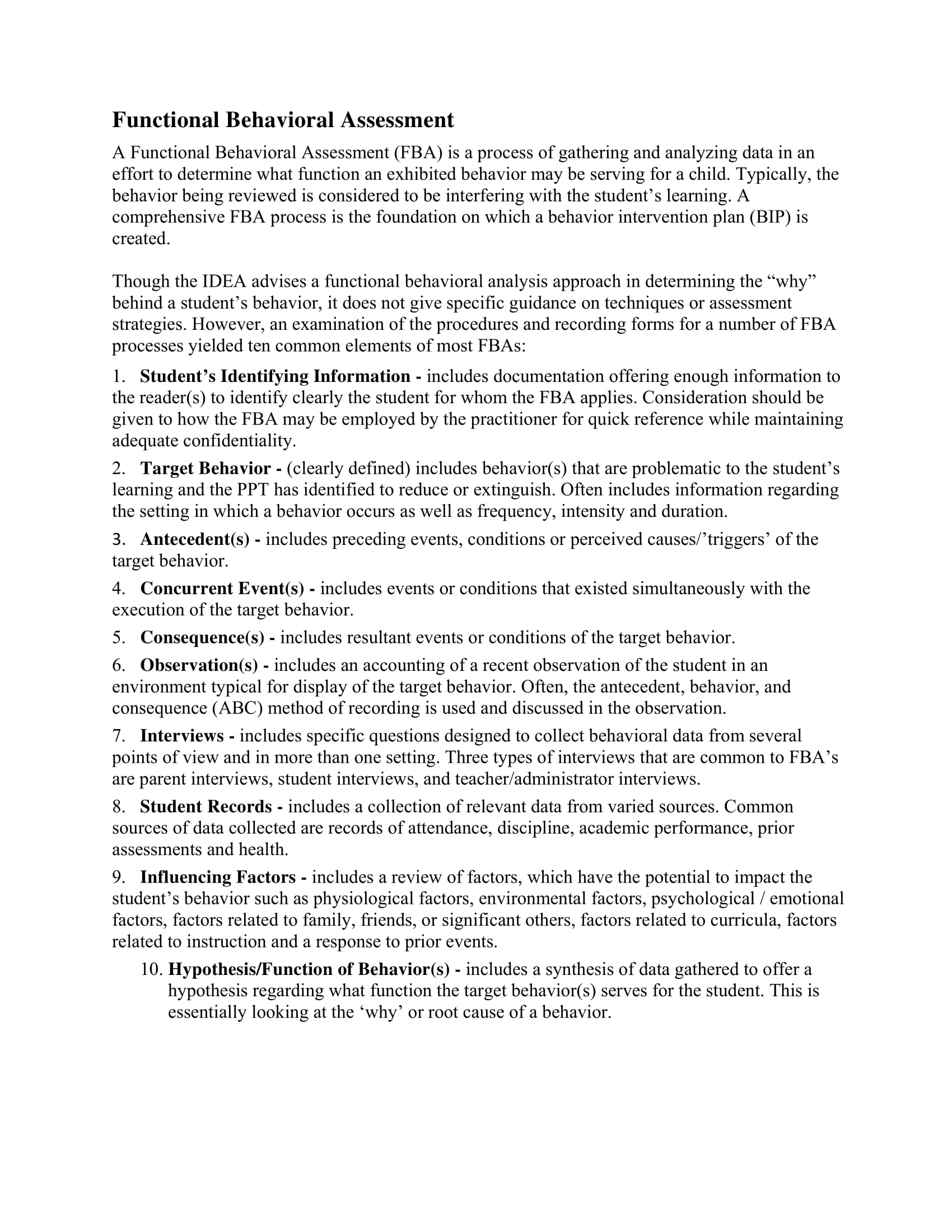10+ Functional Behavioral Analysis Examples to Download
Before coming up with a behavior plan, it is essential for you to first develop and use a functional behavioral assessment with functional analysis. To make it more understandable if it is your first time to hear these terms, functional analysis is one of the steps that you can take if you want to immerse in the processes of functional behavior assessment. From previous health records and health assessment examples up to the interview results from the individual’s parents and attending staffs, it is important for you to ensure the comprehensiveness of the document that you will come up with so you can fully execute action plans for the benefit of the entity whose behavior is being analyzed.
We have listed different kinds of functional behavioral assessment and functional analysis examples that you can refer to if you want to create a functional behavioral analysis document. Make sure to look into all the details of the references that we have provided you with in this post so that you can develop, format, use, and present an effective functional behavioral analysis. You may also see Cash Flow Analysis Examples.
Functional Behavioral Analysis Example
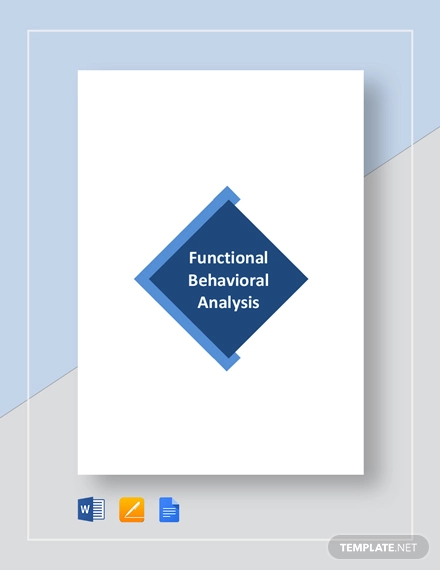
Functional Behavioral Assessment and Positive Interventions Example
Behavior Intervention and Support or Strategies Example
Steps in Creating a Functional Behavioral Analysis
In comparison to the development of an employee SWOT analysis, creating a functional behavioral analysis also has a process that can direct you to the creation of an effective document. The basic steps that you can follow if you want to start the development of a functional behavioral analysis are as follows:
- Browse through a number of references like templates, existing functional behavioral analysis of your organization, and downloadable examples. Having document guides can give you an idea on how you will develop the specific functional behavioral analysis that you need.
- Once you have already decided on what format and discussion flow to use based on the evaluation, discussion, and presentation that you would like to have, you can already outline or draft the steps that you need to take so you can have an organized analysis. You may also see earned value analysis examples & samples.
- Start the content of the document by providing information about the patient and other entities involved in the transaction. Include the dates in which observations have been made and other details that you think are essential for the undertaking.
- Define the behavior that you have observed that you think is inappropriate. You have to be specific when describing the behavior so that it will be easier for you to monitor it and get more information that can be used for the analysis. Being precise in your specifications can also be very useful if you are working with a team as it can lessen the instances of misunderstandings or the presence of misleading information.
- Be observant of the child or the patient’s behavior. Collect as much supporting details as possible. It will be more efficient for you to compare data if you have a good selection range of information at hand. Since you need to record a lot of instances from observations, it is essential for you to have a well-arranged document format. Make sure that you will be detailed when presenting behavior observations so you can create an accurate document. You may also see job analysis examples.
- Look into the previous records of the individual, if there are any. This will allow you to identify whether there are trends when it comes to the location, time, and frequency that the behavior is occurring or is triggered. This can also help you a lot when it comes to your analysis as you already have initial data to work with and all you need to do is to gather more evidences.
- List down the things that happen prior to and after the behavior. You can also identify the people who are present when the behavior occurs. A well-rounded analysis is highly recommended as it can allow you to be particular and in-depth when discussing results, insights, and recommendations.
- Create a hypothesis from the details that you have gathered. Make sure that you will not forget to include the reasons for the behavior and the factors or elements that triggers it. Understanding the situation can help you create decisions that will be helpful to the patient and other entities involved. You may also check out here job safety analysis examples.
- Suggest a behavior intervention plan that can provide an idea on how the inappropriate behavior can be removed or replaced. It will be best if you can come up with a variety of options so that there will be other plans of action that can be implemented should one or more of your suggestions be proven to not work out in the case of the individual.
- Finalize the document and ensure that the patient is aware of the analysis results. This will allow him or her to set proper expectations especially when it comes to his or her control toward the behavior being analyzed. However, take note that this is on a case-to-case basis depending on the condition of the patient. Make sure to work with experts and get the approval of the patient’s legal guardians. You may also see training needs analysis examples.
Analysis Implementation of Functional Behavior Assessment Example
Functional Behavior Analysis Example
Why Do You Need to Create a Functional Behavioral Analysis?
When you have already decided to make a business case analysis, a market analysis, a functional behavioral analysis, or any other kinds of analyses, it is imperative for you to be aware of the reason on why it is necessary for you to come up with a comprehensive and detailed document. You need to be guided by goals and objectives so you can make sure that the effectiveness of the analysis can highly impact the entities within the processes of behavioral intervention. A few of the reasons why it is recommended for you to create a functional behavioral analysis every time you involve yourself in behavior intervention include the following:
- Creating a functional behavioral analysis can allow you to set a baseline of behavior in which intervention results can be compared to. This will help you identify whether the behavior improvement strategies that you executed worked out. Hence, having a functional behavioral analysis can make your behavior intervention become more measurable and easier to monitor. You may also see event cost analysis examples.
- Developing a functional behavioral analysis can present realistic and relevant information. This particular type of analysis needs to be recorded accordingly as you should not rely on initial contact with the patient or more so your intuition about the reasons for his or her behavior. Having all the necessary details of your continuous analysis can result to an efficient, comprehensive, and outstanding document.
- Using a functional behavioral analysis can make it more efficient for you to track elements, factors, and other items that affect the way a patient behaves. Knowing the internal and/or external factors that trigger or prompts the behavior can give you an idea on how you will handle the situation so that you can see favorable and positive results aligned with the improvement or change of the patient’s behavior. You may also see business systems analysis examples.
Functional Behavioral Assessment Example
Functional Behavioral Assessment Practical Example
What Is a Functional Behavioral Analysis?
Knowing what a functional behavioral analysis is and the ways on how you can maximize the benefits from using it are only some of the initial things that you have to look into whenever you plan to create the specified document. The same goes when making training needs analysis or any other types of business document. If you can have an in-depth understanding of what a functional behavioral analysis can do, it will be faster for you to create a document that is suitable for you and your patient’s specific needs. Listed below are some definitions and descriptions that will allow you to further understand what a functional behavioral analysis is.
- A functional behavioral analysis a part of a behavioral intervention process that promotes understanding to why individuals behave the way they do in varying instances or circumstances. Creating and using a functional behavioral analysis allows the intervention to become more organized, well-guided, and systematic.
- A functional behavioral analysis serves as the document that can help entities know the root causes or core of disruptive behaviors. The presence of this document allows the credibility of the actual analysis to be observed since all details are firsthand and are based on actual observations rather than unverified or unsupported conclusions. You may also see failure analysis examples.
- A functional behavioral analysis is used to ensure that there is a strong basis or solid foundation in the development of a behavior intervention plan. Finalizing your recommendations is very important as it can affect the development of the patient. Using a functional behavioral plan can make it easier for you to incorporate your strategies to allow the behavior of the patient to change as planned. You may also see hazard analysis examples.
- A functional behavioral analysis can make it easier for individuals to get the help that they need. The creation and implementation of this material or tool is a collaborative process. Through positive reinforcement and an effective analysis, patient can easily understand their behavior and why it is necessary for them to make changes alongside the other involved entities and those who are responsible for the analysis.
- A functional behavioral analysis presents results and insights in consideration not only of the actual behavior but also of the environment and other items that the patient is exposed to. Being able to do this can establish accuracy with the details relevant and aligned with the behavior being observed. This can then result to a more precise and functional planning for actual behavior intervention. You may also see job task analysis examples.
Functional Behavioral Analysis Conduct Example
Functional Behavioral Assessment Document Example
Benefits of Using a Functional Behavioral Analysis
The advantages of having a functional behavioral analysis should be observed not only with the results that it can bring but also on how it affected the efficiency and effectiveness of the entire analysis process. In comparison to a vendor analysis, your functional behavioral analysis should also be measured or assessed through the baselines that you have set prior to the document’s development and usage. Some of the benefits that can be experienced by entities involved in behavior intervention processes where the functional behavioral analysis will be used are as follows:
- If you will have a functional behavioral analysis at hand, you can be more aware on how you can change the behavior that is deemed inappropriate. With this, you can align plans of action with the purpose of the analysis and the behavior condition that you would like to see and observe. You may also see product gap analysis examples.
- It is not always easy to identify the elements that trigger behaviors. Hence, using a functional behavioral analysis can allow you to gather more information that can guide you whenever it is already essential to intervene. Addressing behavioral problems in this manner can be very effective as growth and development is incorporated in a variety of ways that are based on the actual condition that the patient is facing.
- There are different techniques that you can learn once you immerse in the creation and usage of a functional behavioral analysis. Through this document, you will know when to use particular intervention approaches. With this, you can easily figure out what to do should behaviors occur or reoccur. Knowing why a patient acts the way he or she does and knowing how to deal with it can contribute to the betterment of the patient’s lifestyle and your ability to react in certain circumstances appropriately. You may also see employee SWOT analysis examples.
Practical Functional Behavioral Assessment Training Example
Functional Behavioral Assessment Model Form Example
Tips in Developing a Functional Behavioral Analysis
Do you want to have an easier time in making a functional behavioral analysis? Aside from the basics of the document’s formatting and presentation, there are still other tips that will allow you to come up with a great and useful discussion. A few of the tips that you can follow in developing a functional behavioral analysis include the following:
- Always describe inappropriate behaviors in a specific manner. Just like when writing a job safety analysis, you have to be objective and precise when listing your findings so that your analysis can be accurate.
- Rely on firsthand information, precise experimentation, and direct assessments. Your observations must be reliable and credible enough so that you can present a functional behavioral analysis that can be trusted by your target audience.
- Identify the actual changes that you expect to see in the behavior. This can guide you in the creation of your action plan for your functional behavioral analysis and behavior intervention processes.
- Consider external factors, behavioral context, causes of the behavior, reaction of other people toward the behavior, and other elements that can affect the way a person behaves. You have to be critical, thorough, and observant when making and using the analysis document so you can get results that can add value to your intervention processes and aspirations. You may also see situation analysis examples.
Are you now ready to create a functional behavioral analysis? Whether it is your first time to develop the specified document or you just want to ensure that you will come up with an outstanding analysis, we suggest you to check out the downloadable examples in this post. Moreover, do not hesitate and always feel free to review the discussion that we have made for you so you can have useful guides, tips, and references during the creation of your functional behavioral analysis. You may also see product analysis examples.





